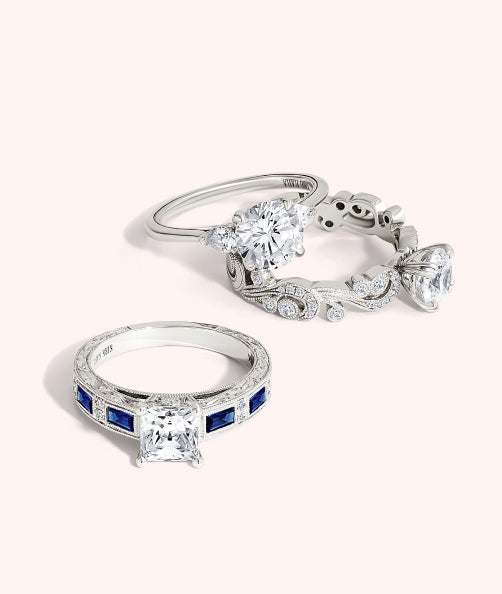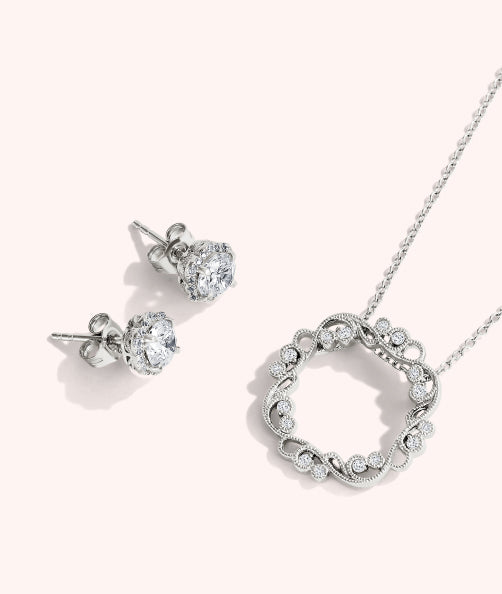Guide to Lab Grown vs. Natural Diamonds

Natural Diamonds
Natural diamonds are formed deep within the Earth's mantle, typically around 90 to 150 miles below the surface, under conditions of extremely high pressure and temperature. They are composed of carbon atoms arranged in a crystal lattice structure, creating equal strength in all four directions granting diamonds their immense hardness. These carbon atoms result in an octahedron. The process of diamond formation begins with carbon being subjected to intense heat and pressure, causing the carbon atoms to crystallize into diamond over millions or even billions of years. These diamonds are then brought closer to the Earth's surface via volcanic eruptions or through geological processes such as kimberlite and lamproite pipes. Diamonds were first formed deep within the Earth's mantle billions of years ago, however, that does not mean it took billions of years to form. Scientists have not been able to determine the exact amount of time required for formation, but the prevailing theory is that diamonds formed quickly, in some cases instantly. Some diamonds formed over a longer period of time, stopping and starting. Once diamonds were brought to the surface, it wasn’t long before humans were fascinated with their unique beauty. There are two main methods are employed, open-pit mining and underground mining. Open pit mining involves the excavation of large pits to access diamond-bearing ore. It's commonly used when diamond deposits are relatively close to the surface. When diamond deposits are deeper in the crust, underground mining methods are employed. This can involve shaft mining, where vertical shafts are dug to access the ore, or tunneling techniques to access the ore horizontally. Underground mining requires more complex infrastructure and is typically more expensive than open-pit mining. In some areas, a less invasive version can be used on the sea floor, to dredge diamonds from volcanic rich areas.
Today, natural diamonds continue to be mined which creates concerns over environmental impact and labor practices. The spotlight on ethical sourcing of diamonds has led to the development of the Kimberley Process, aimed at regulating the diamond trade and preventing the sale of "conflict diamonds" mined in war zones and used to finance armed conflict. The Kimberly process purportedly accounts for 99.8% of the global production of rough diamonds and acts as a force for good globally. At Kirk Kara, we pride ourselves with creating and selling ethical diamonds as part of the Kimberly process.
SHOP natural diamondsLab Grown Diamonds
First and foremost, lab grown diamonds ARE diamonds. They have the same physical and optical characteristics of natural diamonds, with one notable difference, their origin. Lab grown diamonds are technological marvels, created using either High Pressure High Temp (HPHT) or Chemical Vapor Deposition (CVD) growth methods producing variations in quality and purity. While natural diamonds form below the earth’s surface, lab grown diamonds are grown from a diamond crystal seed in a laboratory reactor. The difference between the growth of a natural and a lab grown diamond is microscopic in chemical structure. Natural diamonds have nitrogen impurities that break into the carbon lattice structure under the earth’s surface. Lab grown diamonds, notably CVD grown, are devoid of nitrogen as a result of their controlled origin. This, in combination with certain growth patterns, are tiny determinants in discerning if a diamond is lab grown or natural. The growth method is not as important as an individual grower’s technological skills. Executed well, both processes (HPHT and CVD) produce breathtaking, high caliber diamonds. The main takeaway from purchasing a lab grown diamond is they are beautiful, ecologically and socially conscious diamonds of the utmost quality.
shop lab grown diamonds
OUR PROMISE TO YOU
Every ring bearing the Kirk Kara name is an original hand crafted design that exceeds the highest standards in our industry.





